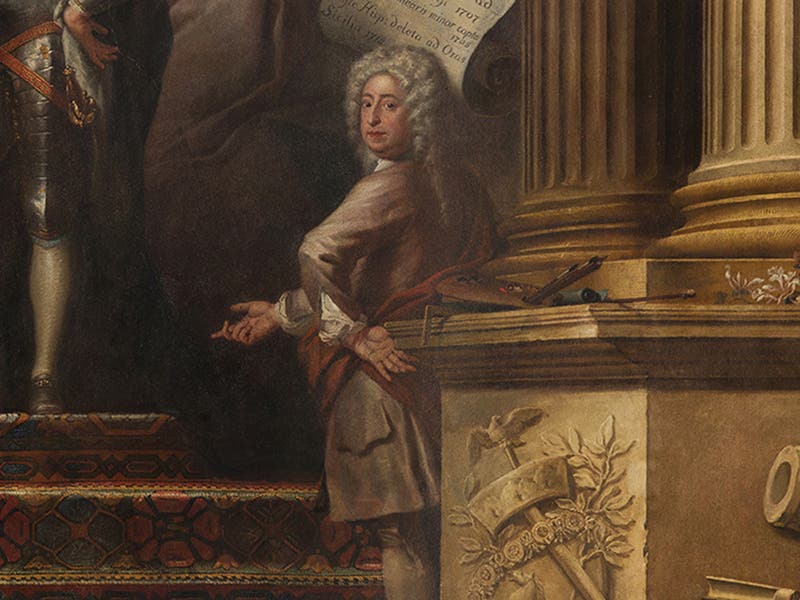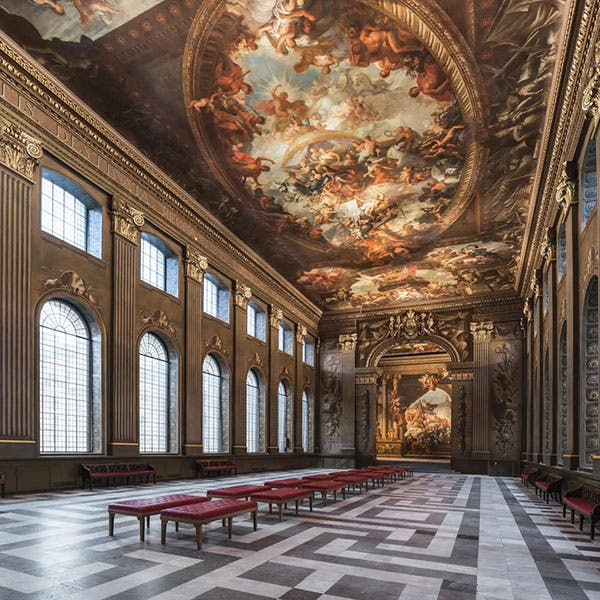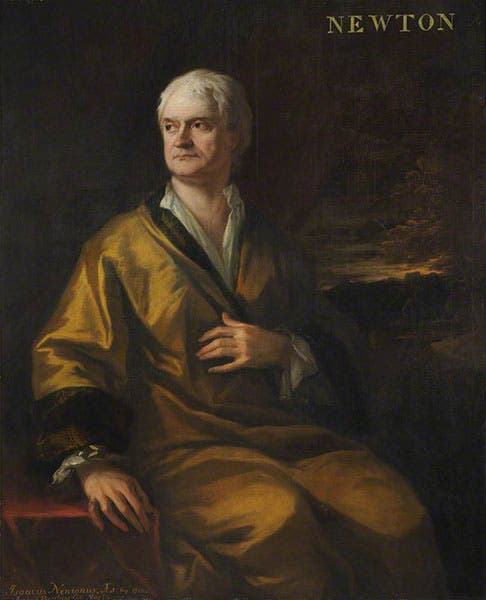Scientist of the Day - James Thornhill
James Thornhill, an English artist, was born July 25, 1675, or 1676. Thornhill is known as a historical painter, and an indefatigable one, since he painted the entire ceiling and much of the walls of the dining hall of the old Greenwich Hospital, so that it is now known as the Painted Hall, and is often referred to as the Sistine Chapel of the United Kingdom, which is more than a bit of a stretch (third image). Many of the figures depicted are Protestant Kings and Queens of England, but there are some scientific figures hiding in the wall-work, including Copernicus, Tycho Brahe, John Flamsteed, and Thornhill himself, in an ostentatious self-portrait (second image).
Thornhill also painted more than a few portraits, and while most of them were for people who could afford such portraits, and thus of little historical interest, a few were scientists. His most famous sittee was Isaac Newton, whom he painted twice, both times giving us a Newton without wig, which wigless generations like ours appreciate. We show the one at Trinity College, Cambridge, painted in 1710-11 (fourth image), when Newton was about to have himself declared the official inventor of calculus, despite cries of "foul" from a legitimate contender for the title, Gottfried Leibniz.
But today, we are going to focus on Thornhill's side career as a depictor of celestial constellations. John Flamsteed had been recording the positions and magnitudes of the stars ever since he became Astronomer Royal in 1675. He was more interested in publishing a stellar catalog than an atlas, and that would come to be, eventually, after his death, but he realized that a star atlas was a necessary accompaniment to a star catalog, if he were to follow in the tradition of great star cataloguers, such as Johannes Hevelius. Thornhill agreed to depict the constellation figures for the 27 large plates of Flamsteed's intended atlas. He appears to have taken on this commission about the time that he began the Painted Hall project, in 1715, so his plate was very full for the next ten years. Flamsteed died in 1719, so most of the ordeal of commissioning drawings from Thornhill and copper plates from a variety of engravers (in England and on the Continent) had to be undertaken by Flamsteed's executors. But the atlas was completed and finally published as Atlas coelestis in 1729, and it was, physically, the largest star atlas ever published, and the most accurate, since Flamsteed had telescopic sights on his instruments, which Hevelius had refused to use, so Flamsteed's star positions were more accurate.
But the constellation figures were, in most people’s opinions, and certainly in mine, less than successful. Ignace-Gaston Pardies had set such a lofty bar with the beautiful figures in his star atlases of 1674 and 1690, and Hevelius had kept the bar high with his Firmamentum of 1690, so one had every reason to expect that Thornhill would be motivated by his predecessors to rise even higher aesthetically, but if he tried to paint a pleasing constellation-filled sky, he failed miserably. Two of the plates are reasonably attractive in composition and delineation, the one depicting Andromeda and Perseus (first image), and the plate showing Bootes with the hunting dogs, and Coma berenices (fifth image); to be kind, we used these as our first two examples of Thornhill’s constellation art.
But the presentation of Virgo (sixth image) is extremely odd, with her wings on the front – it is almost as if Thornhill drew here initially from the back, as if she were on a star globe, and then was told to depict her from the front, which he did, without relocating the wings.
The figure of Aquarius seems to have suffered from the same deficiency (seventh image), and so too the figure of Auriga, which we show in a detail, so you can admire, or not, Thornton’s linework and skill in depicting faces (eighth image).
There is very little scholarship on Thornhill’s career as a celestial cartographer, which is too bad, because I am sure that if some of the art historians who have written about the Painted Hall would take a look at the Atlas coelestis, they would have some interesting things to say about what Thornhill was doing, and why. All can do is show the engravings, and wonder.
One bright feature of Flamsteed’s Atlas coelestis of 1729 is that when it was re-issued in smaller format in French and German in the 1770s, the constellation figures were considerably improved.
James Thornhill was knighted, the first native-born British artist to be given that honor. The title was bestowed, however, in 1720, well before the Atlas coelestis was published.
William B. Ashworth, Jr., Consultant for the History of Science, Linda Hall Library and Associate Professor emeritus, Department of History, University of Missouri-Kansas City. Comments or corrections are welcome; please direct to ashworthw@umkc.edu.

![Andromeda and Perseus, constellations figured by James Thornhill, with star positions determined by John Flamsteed, in Atlas coelestis, plate [15], 1729 (Linda Hall Library)](https://assets-us-01.kc-usercontent.com:443/9dd25524-761a-000d-d79f-86a5086d4774/1b30cfec-5be6-4297-a7fb-97255ba992e5/thornhill1.jpg?w=534&h=582&auto=format&q=75&fit=crop)
![Andromeda and Perseus, constellations figured by James Thornhill, with star positions determined by John Flamsteed, in Atlas coelestis, plate [15], 1729 (Linda Hall Library)](https://assets-us-01.kc-usercontent.com:443/9dd25524-761a-000d-d79f-86a5086d4774/0a0b67a1-9eef-4337-a8ca-5500f5f60e06/thornhill1.jpg?w=800&h=589&auto=format&q=75&fit=crop)



![Bootes, Canes venatici, and Coma berenices, constellations figured by James Thornhill, with star positions determined by John Flamsteed, in Atlas coelestis, plate [19], 1729 (Linda Hall Library)](https://assets-us-01.kc-usercontent.com:443/9dd25524-761a-000d-d79f-86a5086d4774/bb6d4614-6a36-4957-9a58-f043ddc43db6/thornhill5.jpg?w=800&h=593&auto=format&q=75&fit=crop)
![Virgo, constellation figured by James Thornhill, with star positions determined by John Flamsteed, in Atlas coelestis, plate [6], 1729 (Linda Hall Library)](https://assets-us-01.kc-usercontent.com:443/9dd25524-761a-000d-d79f-86a5086d4774/7a3f8902-f859-44b8-9653-b25b3677edb0/thornhill6.jpg?w=800&h=586&auto=format&q=75&fit=crop)
![Aquarius, constellation figured by James Thornhill, with star positions determined by John Flamsteed, in Atlas coelestis, plate [24], 1729 (Linda Hall Library)](https://assets-us-01.kc-usercontent.com:443/9dd25524-761a-000d-d79f-86a5086d4774/d89c2f60-5308-4b77-a3ca-947a603e1ca9/thornhill7.jpg?w=781&h=600&auto=format&q=75&fit=crop)
![Detail of Auriga, constellation figured by James Thornhill, with star positions determined by John Flamsteed, in Atlas coelestis, plate [16], 1729 (Linda Hall Library)](https://assets-us-01.kc-usercontent.com:443/9dd25524-761a-000d-d79f-86a5086d4774/35e52993-fcad-4e50-8f5a-8191a8828bdc/thornhill8.jpg?w=506&h=600&auto=format&q=75&fit=crop)




